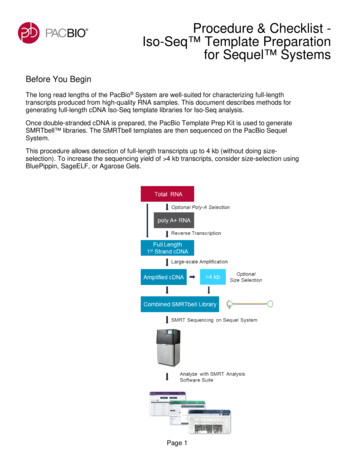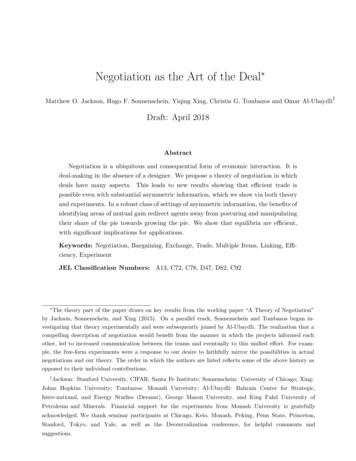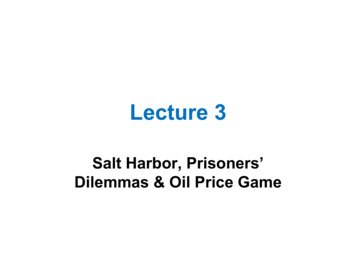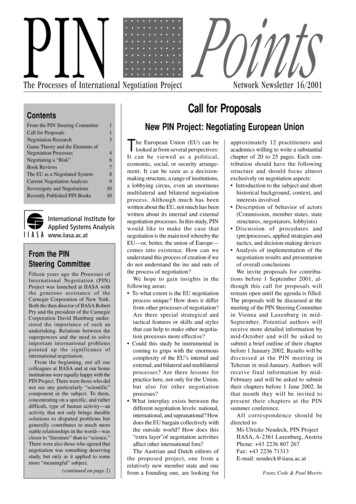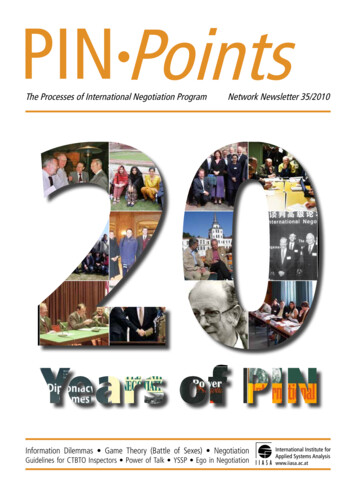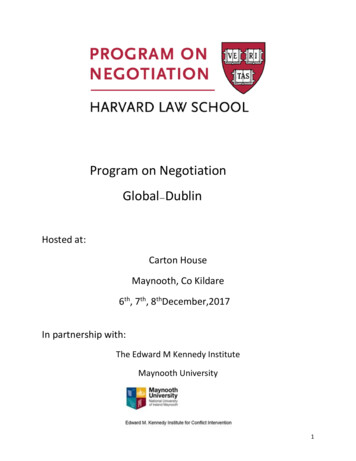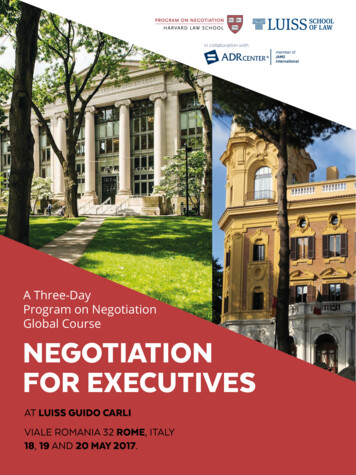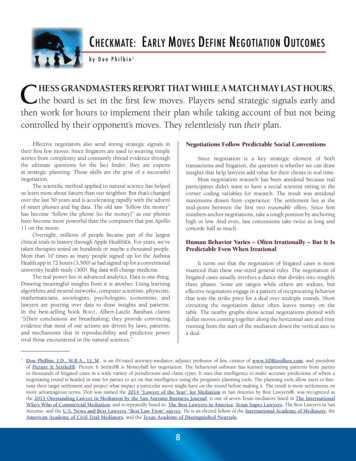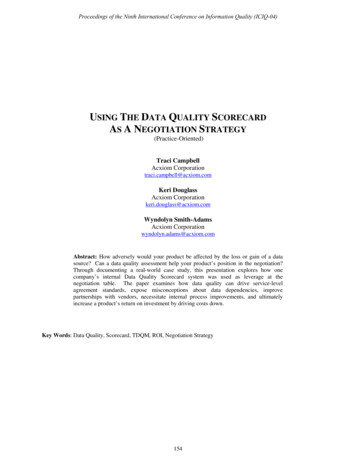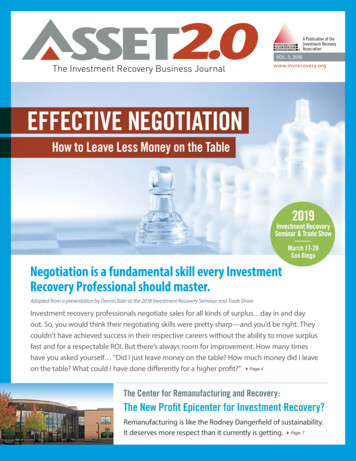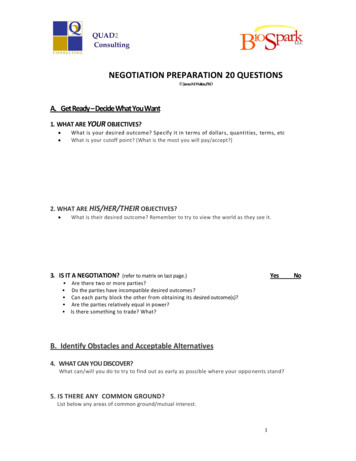
Transcription
QUAD2ConsultingNEGOTIATION PREPARATION 20 QUESTIONS JamesM.Walters,PhDA. Get Ready – Decide What You Want1. WHAT ARE YOUR OBJECTIVES? What is your desired outcome? Specify it in terms of dollars, quantities, terms, etcWhat is your cutoff point? (What is the most you will pay/accept?)2. WHAT ARE HIS/HER/THEIR OBJECTIVES? What is their desired outcome? Remember to try to view the world as they see it.3. IS IT A NEGOTIATION? (refer to matrix on last page.) YesAre there two or more parties?Do the parties have incompatible desired outcomes?Can each party block the other from obtaining its desired outcome(s)?Are the parties relatively equal in power?Is there something to trade? What?B. Identify Obstacles and Acceptable Alternatives4. WHAT CAN YOU DISCOVER?What can/will you do to try to find out as early as possible where your oppo nents stand?5. IS THERE ANY COMMON GROUND?List below any areas of common ground/mutual interest.1No
6. IS THERE A POSSIBLE WIN/WIN?What, from your perspective, might be any win/win areas:7. CAN YOU SEE POSSIBLY ACCEPTABLE ALTERNATIVES?What new alternatives can you brainstorm that might be broug ht to the table?8. THINK ABOUT A CONTINGENCY PLAN. Are there external constraints that would impede bargaining such as geography,time, legal considerations, competitive information, etc? If so, how can you handle? What is the most likely package you will be offered? What/Why? What will be your response (public / private) to the above? What other conceivable moves could the other party make? What would be your response to the above moves?9. WHAT ARE THE SHORT-TERM/LONG-TERM CONSEQUENCES FOR YOU? Short-Term: Long-Term:2
C. Manage The Negotiating Environment and Agenda10. WHO WILL NEGOTIATE? An individual or a team?If an individual, who?If it is a team, clearly specify the decision-making authority role of each member.Team leader:Member 1:Member 2: -Member 3: --Leadership style : ----------------------11. WHAT WILL YOU TALK ABOUT?Specify your agenda for bargaining; indicate what you will discuss and your preferred order to discuss them.12. HOW FLEXIBILE ARE YOU PREPARED TO BE ON THE AGENDA? Do you have a flexible agenda?Yes NoIs there anything you can do to make it more flexible?13. WHERE WILL YOU NEGOTIATE?Your territory:Their territory:Neutral territory:Where exactly and what can/will you do to assure it works for you?14. WHEN WILL YOU NEGOTIATE? Specify any time pressures/deadlines facedD. Manage The Transaction And Yourself15. WHAT WILL YOUR INITIAL OFFER BE? What will your initial offer be? What do you consider this: High ball, Low ball; Last Best? Why What, if any, are points that you’re willing to compromise on?3
16. WHAT KIND OF BARGAINER WILL YOU BE? (Refer to your Negotiating Style Assessment & Shell’s matrix.) What is your natural style? What do you think is his/her’s/their’s? What style can you possible adopt (if necessary)?17. WHAT VERBAL NEGOTIATION TACTICS ARE YOU PREPARED TO USE?Choose which of the following you will use and under what circumstances: Promises Normative appeals Threats Commitments Recommendations Self-disclosures Warnings Questions Comman d s Rewards Punishments18. HOW WILL YOU FRAME THE INTERACTION? (Refer to “Principles & Approaches” document.)What can you do to put/keep this negotiation in a mutually effective frame?19. ANTICIPATE IF YOU AGREE. What is the degree of ambiguity in the settlement? What is the degree of formality in the settlement? What is the duration of the contract? Are there renewable options?20. ANTICIPATE IF YOU DISAGREE. What is your action plan? Will you use any of the following: Mediation; Arbitration; Final offer arbitrationSpecify who.4
NEGOTIATION’S PLACE IN THE STRATEGY OPTIONS FRAMEWORKAlthough there are an endless number of situations where two or more parties must engage witheach other to achieve an outcome, not all of those situations call for negotiation. We have definednegotiation as “a process by which two parties communicate with each other in order to reach anoutcome on which they mutually agree.” The key word is “mutual” and with a moment of reflectionone can see that not all outcomes must be mutually agreed to. In any organization that has a powerhierarchy, for example, some roles are vested with the power of command, and while agreementmight be desirable, compliance might be all that is required.Negotiation, therefore, -- i.e communication to achieve a mutually agreeable outcome – as thenecessary strategy is a function of power. It is also a function of time and mutual trust.The interplay of power, time and trust is illustrated below, with the consequent suggested strategy.If YOURThen yourPOWER isTIME isTRUST is SUGGESTED STRATEGY isHIGHLONGHIGHPROBLEM LOWLONGHIGHACCEDE OR DEFERLOWLONGLOWWITHDRAWLOWSHORTHIGHACCEDE OR DEFERLOWSHORTLOWWITHDRAW5
Negotiation, therefore, -- i.e communication to achieve a mutually agreeable outcome – as the necessary strategy is a function

